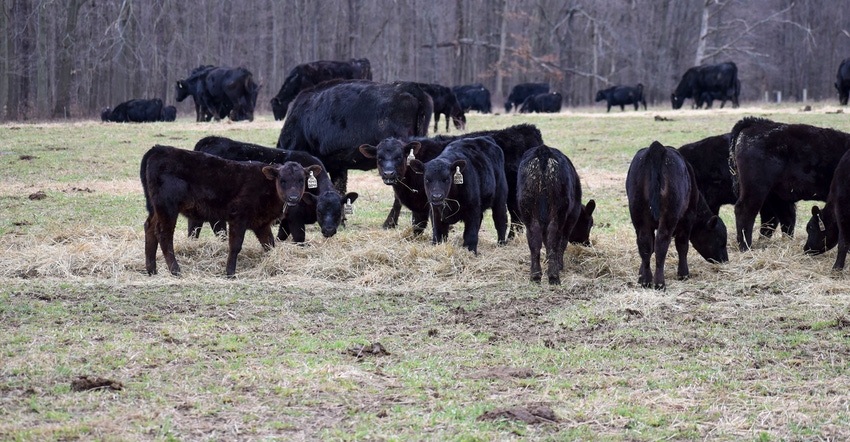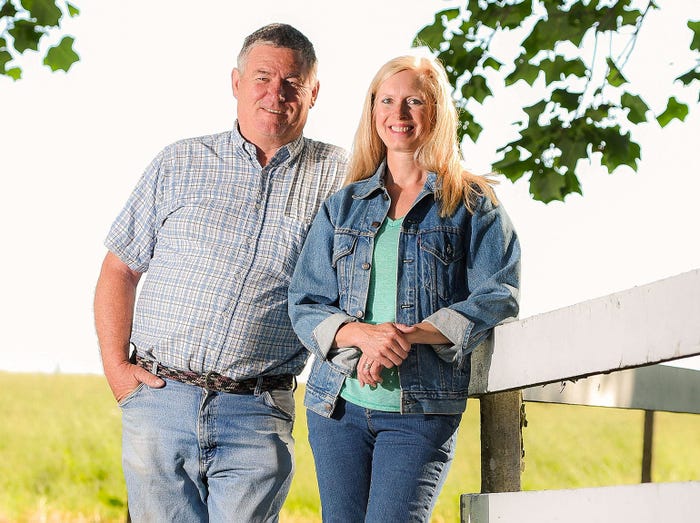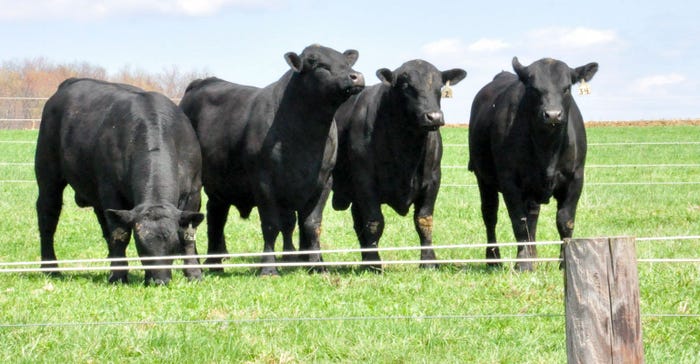April 2, 2020

Providing the best beef on consumers’ plates is the goal of McKean Bros. Angus in Mercer, Pa.
The farm, which continues to be operated by family, was purchased by Bob and Peggy McKean in 1972. They raised three boys on the farm and their oldest, Greg, and his wife, Peggy, continue to operate it today.
What began as a 250-acre operation has grown to 1,000 acres.
As times and circumstances have changed, Greg and Peggy are no longer interested in growing the farm. But they are always looking to improve the quality of cattle raised there.
Greg took over day-to-day operations in 1978. He and Peggy calve 100 cows a year using a synchronized breeding system.
“By synchronizing we are able to get 75% of the herd bred within 40 days,” Greg says. They use one of their own bulls to get the rest of the herd bred. They plan for calves to be born within about 70 days, beginning around Christmas.
“It is a very busy time. One day we had 10 born this year,” Peggy says.
Developing calving ease and strong mothering skills are top priorities.
“A mother should be able to get her calf up and sucking within 20 minutes,” she says. “We don’t keep the ones who don’t show good mothering skills.”
“We breed for fertility, calving ease, docility and muscle,” Greg says, adding that these qualities are crucial for a good end product. “There is just the two of us. We can’t afford for either one of us to get hurt.”
The couple have seen a change in personality of Angus cattle over the past 20 years. Cattle today are much more docile and easier to handle.
 IMPROVING AND ADJUSTING: Greg and Peggy McKean run McKean Bros. Angus. They’ve shifted their thinking over the years from expanding the operation to making improvements using synchronized breeding and incorporating genomic testing.
IMPROVING AND ADJUSTING: Greg and Peggy McKean run McKean Bros. Angus. They’ve shifted their thinking over the years from expanding the operation to making improvements using synchronized breeding and incorporating genomic testing.

The McKeans continually improve the genetics of their own herd so they can provide quality genetics to other breeders through their annual sale. About 80% of their calves are raised for seed stock. 20% are raised for beef.
“We have had an annual sale on out farm for 15 to 20 years on the last Friday in April,” Greg says. “We have many repeat customers.”
Expanding genomic testing
About five or six years ago, the McKeans began doing genomic testing of their herd.
“The results of the genomic tests give us information EPD [expected progeny difference] about a year sooner,” he says. “We do our testing in December. We test both bulls and heifers.”
This information is used to predict how an animal will perform in the future and is provided for all animals that are in their bull and female sale.
The EPD is the prediction of how future progeny of each animal are expected to perform relative to the progeny of other animals listed in the database, according to the American Angus Association. EPD becomes more detailed and accurate as the progeny of the bulls start exhibiting the traits important to producers.
Genomic testing provides the breeder with information on traits the animal is carrying. Cattle breeders use this information to determine what animal is carrying the traits they want in their herd.
 QUALITY SEED STOCK: Greg and Peggy McKean raise 80% of their calves for seed stock. They hold a sale every year on the farm.
QUALITY SEED STOCK: Greg and Peggy McKean raise 80% of their calves for seed stock. They hold a sale every year on the farm.

The first identification of the three-dimensional double helix structure of DNA was in 1953, according to an article published by University of Georgia Cooperative Extension. In explaining their discovery, American biologist James Watson and English physicist Francis Crick said, “This structure [DNA] has novel features, which are of considerable biological interest.”
Thirty years later, Alec Jefferys developed a process for genetic fingerprinting, a process for identifying individuals based on their unique genetic code. In the early 1980s, Israeli scientists M. Soller and J.S. Beckmann described the possible uses of DNA-based technology in livestock breeding, which continues to be used today.
Summer field day set
For beef producers, the science isn’t as importance as the information that’s provided in the pedigrees for the animals they raise; the bulls they use for A.I.; or the animals they consider adding to their herds.
This year, McKean Bros. Angus is hosting a beef field day on July 25. It is a joint effort of the Pennsylvania Angus Association, Pennsylvania Cattlemen’s Association, the Center for Beef Excellence and the PA Beef Producers Working Group. Besides workshops, there will be opportunities to visit the McKean Bros. Angus herd.
Visit the McKean Bros. online to learn more.
Gregg writes from western Pennsylvania.
About the Author(s)
You May Also Like






